|
|
|
Sort Order |
|
|
|
Items / Page
|
|
|
|
|
|
|
| Srl | Item |
| 1 |
ID:
102856
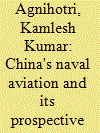

|
|
|
|
|
| Publication |
2011.
|
| Summary/Abstract |
The PLA Navy's aviation branch, officially known as the PLA Navy Air Force (PLAN AF), comprises 25,000 personnel and more than 800 aircraft. It provides the PLA Navy with its own air capability independent of the PLA Air Force. But the Force remains largely land-based. However, the much speculated upon aircraft carrier program will impart a new dimension to the Chinese naval aviation. With the current level of national technological capability and available maritime infrastructure, the PLA Navy will, at best, be able to project power with its carriers within the South and East China Sea only, in the 2020 timeframe. It will find it increasingly hard to project power-using aircraft carriers in the Indian Ocean Region without full-fledged military bases to support logistics and ship and aircraft maintenance/repairs. Thus the credible Chinese power projection capability in the Indian Ocean still appears to be at least two decades away. But the international community must take due cognizance of this inevitability now and commence preparations to face this forthcoming challenge.
|
|
|
|
|
|
|
|
|
|
|
|
|
|
|
|
| 2 |
ID:
102862


|
|
|
|
|
| Publication |
2010.
|
| Summary/Abstract |
It has been 18 months since the cessation of the armed conflict between the Government of Sri Lanka (GOSL) and the rebel forces of the Liberation Tigers of Tamil Eelam (LTTE). Although the war has finally come to an end, one cannot conclude that the core issue of Tamil minority rights and cultural autonomy has been resolved. Drawing from the theory of multiculturalism, this paper argues that the Sri Lankan state has interpreted and assessed minority group rights and cultural autonomy as a threat to its national security, thereby securitising the debate on Tamil minority rights, which led to a self-fulfilling prophesy. Moreover, it argues that the end of the civil war presents an opportunity for the state to shift its interpretive logic of minority rights from security to justice in order to address the core issue of cultural autonomy in Sri Lanka.
|
|
|
|
|
|
|
|
|
|
|
|
|
|
|
|
| 3 |
ID:
102864
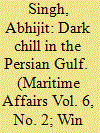

|
|
|
|
|
| Publication |
2010.
|
| Summary/Abstract |
This article reviews the sustained growth of Iran's naval forces in the past two decades. It closely examines the Islamic Republic's navy's war-waging capacity in the Persian Gulf, its new unconventional fighting philosophy, force imperatives, doctrinal underpinnings, combat objectives, and the implications that this might have on shipping and oil trade in the Persian Gulf. Experts have long speculated that Iran is developing its asymmetric capabilities aimed at paralysing the Persian Gulf and the eventual expansion of its sphere of influence. Interfering with the supply of oil would raise oil prices sharply and would certainly stall the still moderate global economic recovery, thereby plunging the world again into a global recession. Analysis shows that the modernisation of its naval forces might be the clearest indication that Iran may well be systematically developing the means to do so. This is brought home starkly by the beefing up of the Revolutionary Guards' Navy and its "swarming" capabilities. With a newfound assertiveness and aggressive tactics, the Iranian naval forces are now challenging the dominant force in the Persian Gulf - the US Navy. And even though the success of such an approach at this stage appears unlikely, they may still hold some key cards, to be able to pose a credible and effective threat.
|
|
|
|
|
|
|
|
|
|
|
|
|
|
|
|
| 4 |
ID:
102867
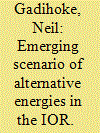

|
|
|
|
|
| Publication |
2010.
|
| Summary/Abstract |
The energy transition from fossil fuels to renewable sources of energy is moving much faster than could be imagined a few years ago. Given this unanticipated acceleration, it is widely believed that renewable energy is attaining a momentum which is of great significance in the context of the global energy and climate situation. Whereas the 20th century was marked by the globalisation of the world energy economy as countries everywhere turned to oil, much of it coming from the Middle East, without doubt, this century will see the localisation of energy production as the world turns to wind, solar, tidal, geothermal and other forms of energy. This paper aims to expound the potential of the four main "renewable" energies i.e., wind, solar, ocean and geothermal, including potential assessment of their growth in the (IOR) and the attendant challenges in their future intensification and acceptability. As any study on this topic would bring out, the plans and investment of China are staggering and will have profound implications for the emerging geopolitics.
|
|
|
|
|
|
|
|
|
|
|
|
|
|
|
|
| 5 |
ID:
102855


|
|
|
| 6 |
ID:
102865
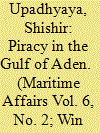

|
|
|
|
|
| Publication |
2010.
|
| Summary/Abstract |
Piracy in the Gulf of Aden, which first emerged as a serious threat in 2005, has since grown manifold, virtually doubling with each passing year between 2006 and 2009. In 2010, though, there was a slight dip in the number of attacks by the Somali pirates the range of piracy attacks has increased significantly. The response of the global community has been remarkably swift. The UN resolution 1816 of 2008 which first authorised nations to deploy warships for counter-piracy operations in Somali territorial waters has since been followed by several international initiatives. Currently over two dozen warships are deployed in the region on anti piracy patrols. Yet, attacks by Somali pirates continue unabated. This paper seeks to highlight the key challenges faced by naval patrols in the Gulf of Aden and brings out the various options that exist for the global shipping industry.
|
|
|
|
|
|
|
|
|
|
|
|
|
|
|
|
| 7 |
ID:
102858
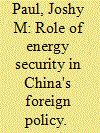

|
|
|
|
|
| Publication |
2010.
|
| Summary/Abstract |
Energy, particularly oil and gas, has become a strategic component of China's foreign and security policy in recent times. Beijing's search for resources for its economic success has created a notion of "scramble for energy" that portrays China's increasing activity in the energy sector worldwide through investment and equity stake considered as a political strategy by the Chinese elites. In this energy hunt foreign policy option, China faces increasing security problems as its energy passes through the Malacca Strait and also the Indian Ocean region. As a result China pays significant attention to secure the sea-lanes of communication and for that Beijing applies a combination of diplomatic and military mechanisms in its overall foreign policy arena. In this scenario, its energy security could lead to some kind friction with other countries of the Indian Ocean littoral area, including India. In this regard this work attempts to analyse different aspects of China's energy security policy and its implication for India.
|
|
|
|
|
|
|
|
|
|
|
|
|
|
|
|
| 8 |
ID:
102860


|
|
|
|
|
| Publication |
2011.
|
| Summary/Abstract |
The International Relations of Southeast Asia have been transformed drastically over the last few decades. The transformation can be attributed to the development of regionalism in the region, following the onset of ASEAN in 1967. Twenty-five years of political cooperation in ASEAN paved the formation of the ASEAN Free Trade Area in 1992. The upcoming ASEAN trade bloc has ushered the integration of the region in various other sectors - with regional security turning out to be the major beneficiary. Considering the fact that Southeast Asia is essentially a maritime region and the maritime space and strategic sea-lanes straddling the region determine the continued existence of these nations, it is pertinent to examine the impact of the regionalisation process on maritime security. The paper aims to highlight the contribution of regionalism towards a secured and stable Southeast Asia. It will examine the maritime cooperation in the region under the ASEAN umbrella.3
|
|
|
|
|
|
|
|
|
|
|
|
|
|
|
|
|
|
|
|
|